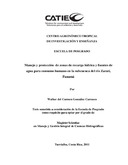Mostrar el registro sencillo del ítem
Manejo y protección de zonas de recarga hídrica y fuentes de agua para consumo humano en la subcuenca del río Zaratí, Panamá
| dc.contributor.author | González Carrasco, W.C. | |
| dc.date.accessioned | 2014-10-18T02:01:43Z | |
| dc.date.available | 2014-10-18T02:01:43Z | |
| dc.date.issued | 2011 | es_ES |
| dc.identifier | 375661 | es_ES |
| dc.identifier.uri | https://repositorio.catie.ac.cr/handle/11554/2932 | |
| dc.identifier.uri | http://orton.catie.ac.cr/repdoc/A7318e/A7318e.pdf | es_ES |
| dc.description | Tesis (M. Sc) -- CATIE, Turrialba (Costa Rica),2011 | es_ES |
| dc.description.abstract | La investigación fue realizada en la subcuenca del río Zaratí, cuyo territorio está inmerso en la cuenca del río Grande, provincia de Coclé, Panamá. Se analizó el marco legal e institucional existente en la subcuenca del río Zaratí relacionado con las zonas de recarga hídrica y el agua para consumo humano, dando como resultado el desconocimiento de las leyes y la no existencia de normas relacionadas explícitamente sobre zonas de recarga hídrica (ZRH), por lo que se hace necesario seguir profundizando en el tema. Dentro de los objetivos del estudio esta analizar la vulnerabilidad global de las principales fuentes de agua para consumo humano y zonas potenciales de recarga hídrica a fin de establecer prácticas para reducir dicha vulnerabilidad. Las vulnerabilidades técnica y educativa resultaron las de mayor relevancia, producto del buen mantenimiento y materiales utilizados en las tomas de agua y la disponibilidad que tienen los residentes de asistir a centros de educación a todos los niveles, desde la primaria hasta la universidad. La vulnerabilidad global encontrada se clasificó como media, por lo que resulta importante ejecutar las medidas o acciones encaminadas a mejorar condiciones de protección de las fuentes de agua y ZPRH, fortalecimiento y coordinación interinstitucional local, educación y el mejoramiento de las condiciones socioeconómicas de la población. The investigation was realized in the sub basin of the Zaratí river, territory which is immerse in the Grande river watershed, province of Coclé, Panamá. The existent legal and institutional framework was analyzed in the sub basin of the Zaratí river related with the water recharge zones and the water for human use, resulting that there is ignorance about the laws and no existence of explicit norMON about water recharge areas(WRA), therefore it becomes necessary to continue deepening in this matter. Among the objectives of the study is to analyzed the global vulnerability of the main water fonts for human use and potential water recharge areas, to establish practices to reduce this mentioned vulnerability. The technical and educational vulnerabilities resulted to be the ones with major relevance, product of the good maintenance and the materials used in the water fonts and the availability of the residents to assist to education centers at all levels, from primary school to university. The found global vulnerabi1ity was c1assified as medium, so it is important to execute measures or actions aimed to improve the protection conditions of the water fonts and the WRA, strengthen and local interinstitutional coordination, education and the improvemen of the socioeconomic conditions of the population. | es_ES |
| dc.language.iso | es | es_ES |
| dc.publisher | CATIE, Turrialba (Costa Rica) | es_ES |
| dc.subject | COSTA RICA | |
| dc.subject | CUENCAS HIDROGRAFICAS | |
| dc.subject | RECURSOS HIDRICOS | |
| dc.subject | ABASTECIMIENTO DE AGUA | |
| dc.subject | ORDENACION DE AGUAS | |
| dc.subject | LEGISLACION | |
| dc.title | Manejo y protección de zonas de recarga hídrica y fuentes de agua para consumo humano en la subcuenca del río Zaratí, Panamá | es_ES |
| dc.title.alternative | Management and protection of water recharge zones and fonts for human use in the sub basin of the Zaratí river, Panamá | es_ES |
| dc.type | Tesis de maestría | es_ES |
| dc.identifier.publication | Turrialba (Costa Rica) | es_ES |
Ficheros en el ítem
Este ítem aparece en la(s) siguiente(s) colección(ones)
-
Tesis [3069]


